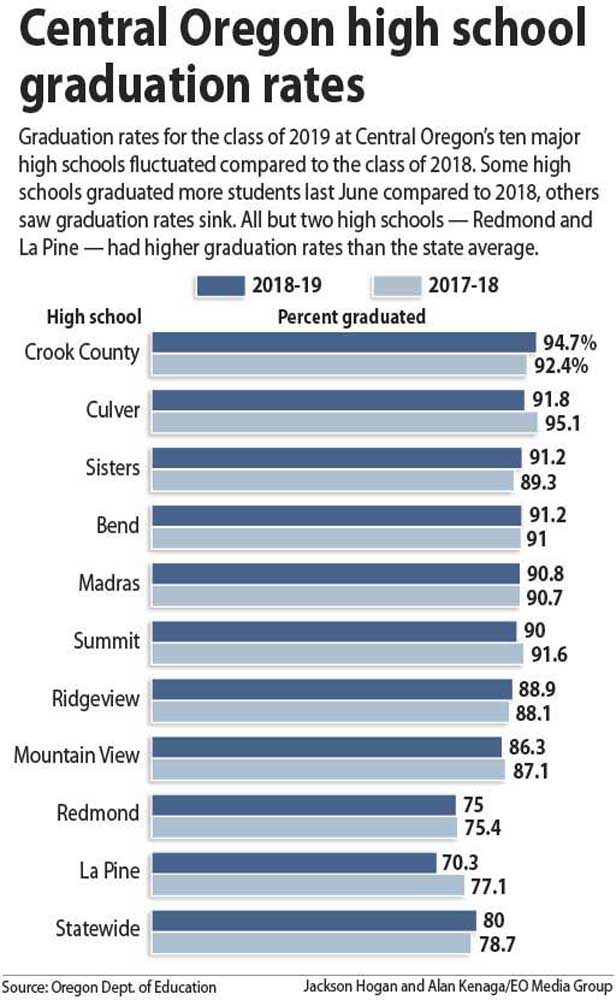Local high schools have mixed graduation rate results in a historic year for Oregon
Published 6:00 am Thursday, January 23, 2020

- 200123_bul_news_ak grad.rates
Oregon had its highest overall high school graduation rate in a decade in 2019, a year in which Central Oregon’s 10 high schools saw varied results.
Only half of the region’s high schools posted a higher graduation rate for the class of 2019 than the year before. Still, all but two local high schools surpassed the statewide graduation rate, which was the highest in recent history at 80%.
Redmond and La Pine high schools had some of the state’s lowest graduation rates for comprehensive high schools, according to state data released Thursday. But others, such as Crook County and Bend high schools, saw increased success in getting students across the graduation stage in June, particularly with students from underserved demographic groups.
Many of these schools’ leaders said they focused on valuing student-staff relationships.
“Our philosophy here is that every data point is a face of a kid,” said Michelle Jonas, principal of Crook County High School. “It’s a whole staff effort of knowing every single kid and not letting them slip through the cracks.”
Bend-La Pine Schools
Three of Bend-La Pine Schools’ four comprehensive high schools saw graduation rates slip in 2019. But La Pine High School had the largest drop, nearly 7 percentage points, to 70.3% of the senior class graduating.
La Pine had the lowest graduation rate in Oregon for high schools with at least 100 students in its senior class, not counting alternative or charter schools.
Matt Montgomery — La Pine High’s principal until this fall, when he moved to La Pine Middle School — said several factors played into the school’s low graduation rate.
Some La Pine students dropped out to earn a General Education Development certificate, commonly known as a GED. Anyone over the age of 18 who isn’t enrolled in a public high school, and doesn’t yet have a high school diploma, can take the GED tests in Oregon.
Montgomery said some of these students opt for taking GED courses rather than attending classes at La Pine because they work full time to support their families.
“Those families are really dependent on those students,” he said.
At 67%, La Pine had the largest percentage of seniors who qualified for free and reduced-price lunch among Bend-La Pine’s four major high schools in 2019.
With a senior class of only 101 students last year, every student that doesn’t earn a diploma knocks 1 percentage point off the graduation rate, Montgomery noted.
The graduation rate at La Pine has remained in the same range — usually between 70% and 80% — for the past eight years. Still, Montgomery said La Pine is taking steps to have more students graduate, like offering more career and technical education classes, and changing its scheduling in the 2020-21 school year to allow students to take more electives.
Meanwhile, Bend-La Pine’s largest high school, Bend High, posted the district’s highest graduation rate in 2019, at 91.2%. That’s only a slight increase from the year prior, but students from underserved groups including Hispanic/Latino students and students experiencing homelessness saw even higher bumps.
Among Bend’s three high schools, Bend High had the highest graduation rate for Hispanic/Latino students, at 86.2%.
Christopher Reese, the school’s principal, partly credited his staff’s ability to build relationships with all students for Bend High’s success.
“Graduation rates are shown to improve when kids get connected to their home school, and they have skin in the game,” he said.
Mountain View and Summit high schools each had a slight dip in 2019 graduation rates, at 86.3% and 90%, respectively. Each school also had a noticeable gap between its overall graduation rate and the graduation rate for Hispanic/Latino students — particularly at Summit, where only 72.7% of that group graduated.
Bend-La Pine Schools staff are working to narrow the split between its Hispanic/Latino and white students through outreach to Latino and Hispanic families and trying to hire a more diverse workforce, said the district’s superintendent, Shay Mikalson. In the 2019-20 school year, only 4% of Bend-La Pine’s teachers identified as Hispanic or Latino, compared to 12% of students, according to state data.
“We’ve made progress, but we still have work to do in having our workforce reflect the student population,” Mikalson said.
Redmond
Redmond School District had a sixth straight year of increasing graduation rates across its two comprehensive high schools and the Redmond Proficiency Academy charter school. More than 83% of seniors graduated districtwide in 2019, compared to only 70.5% in 2014.
“I am proud of the work that these kids are doing,” said Mike McIntosh, Redmond School District superintendent. “We’re climbing that ladder; we’re doing better each year.”
Ridgeview High School’s graduation rate got a small boost in 2019, up to 88.9%. Redmond High had a slight dip, essentially remaining steady at 75%.
Unlike many other large school districts, Redmond doesn’t have an alternative high school. Instead, Redmond High hosts a credit-recovery program, where some students take five years to graduate.
Redmond High’s five-year completion rate, which includes students who dropped out to earn a GED certificate, or took five years to earn a traditional diploma, was 81.3% in 2019.
It was intentional to have students in the credit-recovery program be fully a part of Redmond High School, McIntosh said.
“I wanted those kids to do athletics, go to dances, sing in the choir … because we know engagement is key,” he said.
Crook County
Crook County High School had the highest graduation rate in Central Oregon, surging to 94.7%. The school also had the seventh-highest graduation rate in the state for traditional high schools with at least 100 students in its graduating class.
The school was particularly successful with students from underserved groups. About 92% of students who qualified for free and reduced-price lunch earned a diploma, more than any other Central Oregon school. And, just like in 2018, more than 95% of Hispanic/Latino students graduated.
Jonas, Crook County High School’s principal, credited multiple factors for her school’s success. Those include a high number of career and technical education programs and a period of time each Wednesday when students can get more help for classes they have difficulty in, or retake a test.
Jonas also noted that four years ago, the school hired a graduation coach, McKenzie Kudlac who works one-on-one with seniors and juniors.
“I think that individual attention has been a big influence on the graduation rate,” Jonas said.
Other Central Oregon districts
After nearly doubling its graduation rate between 2015 and 2018, Madras High School hit a plateau with the class of 2019. The school’s graduation rate rose 0.1 percentage points, to 90.8%. However, 92.3% of Madras’ Native American students and 93.8% of its Hispanic/Latino students graduated.
Madras had the highest graduation rate for Native American students in the state.
At Sisters High School, 91.2% of the class of 2019 graduated — a jump of nearly 2 percentage points. However, Sisters students who qualified for free and reduced-price lunch graduated at a lower rate than 2018, with 76.7% of that group earning diplomas.
Nearly 92% of Culver High School’s seniors graduated in 2019. That is a drop of more than 3 percentage points compared to 2018. But as Central Oregon’s smallest traditional high school — there were only 52 students in Culver’s senior class, compared to 386 at Bend High — its graduation rate can fluctuate greatly compared to other schools.
Statewide
In the 10th year of its current graduation rate model, Oregon posted its highest-ever statewide graduation rate, at slightly above 80%.
The state crossed the 80% threshold for multiple reasons, such as programs for specific groups of students and a statewide campaign to promote regular attendance, according to Colt Gill, director of the Oregon Department of Education.
“We’re seeing this as a historical graduation rate achievement,” he said. “We believe it points to … the effort we’ve made to help underserved student groups in Oregon.”






